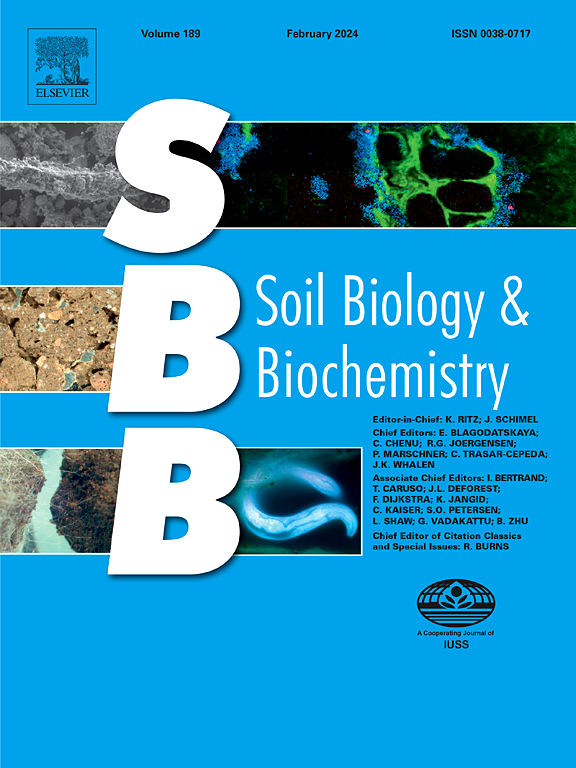Simulated erosion of A horizon influences the dissolved organic matter chemodiversity and carbon sequestration of B horizon in Mollisols
IF 9.8
1区 农林科学
Q1 SOIL SCIENCE
引用次数: 0
Abstract
Erosion of the A horizon of Mollisols is expected to change the dissolved organic matter (DOM) chemodiversity in the underlying B horizon. Three simulated erosion treatments, which had an A horizon of 30, 20, and 10 cm depth, were established for 9 years under a corn-soybean rotation on Mollisols. Compared to the A horizon that was 30 cm deep, the 20 cm treatment had 24–63% more dissolved lignin-like compounds, a significant increase, in the 0–10, 10–20, and 20–30 cm layers of the B horizon. When the A horizon was 10 cm deep, 41% more lignin-like compounds accumulated in the 10–20 cm layer of the B horizon and 22% more lignin-like compounds were detected in the 20–30 cm layer of the B horizon. Relative to the A horizon of 30 cm depth, the 20 and 10 cm treatments reduced the lipid- and protein-like compounds by 69–87% in 10–20 and 20–30 cm layers of the B horizon layers. Labile compounds increased in the 0–10 cm layer of the B horizon but decreased in the 10–20 and 20–30 cm layers of the B horizon. The DOM degradation degree, expressed in terms of the degradation index and Gibbs free energy, were related to the lignin accumulation, indicating that lignin, a recalcitrant compound, was degraded. Notably, variations in DOM chemodiversity in eroded Mollisols were primarily controlled by soil physicochemical properties and not microbial traits. Therefore, eroded Mollisols have less carbon sequestration potential in the B horizon. To prevent soil deterioration in corn-soybean rotations, we recommend to incorporate a combination of organic and mineral fertiliser to a 20–30 cm soil depth in erosion-susceptible Mollisols.
模拟 A 层侵蚀对软质土 B 层溶解有机物化学多样性和固碳的影响
预计莫利土 A 层的侵蚀会改变下层 B 层的溶解有机物 (DOM) 化学多样性。在玉米-大豆轮作的莫利土层上建立了三种模拟侵蚀处理,其 A 层深度分别为 30、20 和 10 厘米,为期 9 年。与深度为 30 厘米的 A 地层相比,深度为 20 厘米的处理在 B 地层的 0-10、10-20 和 20-30 厘米层中溶解的木质素类化合物增加了 24-63%,增幅显著。当 A 地层深度为 10 厘米时,B 地层 10-20 厘米层中积累的木质素类化合物增加了 41%,B 地层 20-30 厘米层中检测到的木质素类化合物增加了 22%。与 30 厘米深的 A 地层相比,20 厘米和 10 厘米处理使 B 地层 10-20 厘米层和 20-30 厘米层的类脂和类蛋白化合物减少了 69-87%。在 B 地层 0-10 厘米层中,易溶化合物有所增加,但在 B 地层 10-20 厘米层和 20-30 厘米层中,易溶化合物有所减少。用降解指数和吉布斯自由能表示的 DOM 降解程度与木质素积累有关,表明木质素这种难降解化合物被降解了。值得注意的是,侵蚀莫利土中 DOM 化学多样性的变化主要受土壤理化性质的控制,而不是受微生物特性的控制。因此,受侵蚀的莫利土在 B 层的固碳潜力较小。为了防止玉米-大豆轮作中的土壤退化,我们建议在易受侵蚀的莫利土壤中将有机肥和矿物肥结合施入 20-30 厘米深的土壤中。
本文章由计算机程序翻译,如有差异,请以英文原文为准。
求助全文
约1分钟内获得全文
求助全文
来源期刊

Soil Biology & Biochemistry
农林科学-土壤科学
CiteScore
16.90
自引率
9.30%
发文量
312
审稿时长
49 days
期刊介绍:
Soil Biology & Biochemistry publishes original research articles of international significance focusing on biological processes in soil and their applications to soil and environmental quality. Major topics include the ecology and biochemical processes of soil organisms, their effects on the environment, and interactions with plants. The journal also welcomes state-of-the-art reviews and discussions on contemporary research in soil biology and biochemistry.
 求助内容:
求助内容: 应助结果提醒方式:
应助结果提醒方式:


